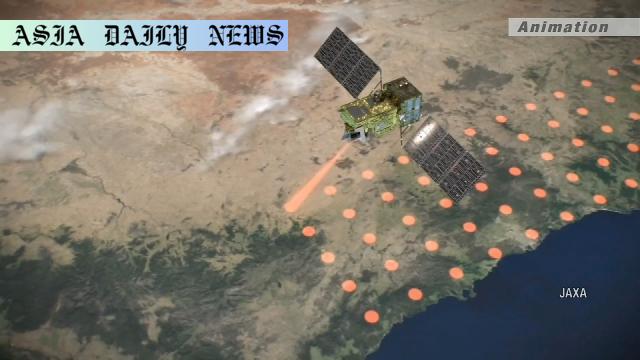CO2 Emissions: Satellite data reveal Earth’s atmospheric CO2 levels in 2024 had the largest year-on-year rise since 2010.
Satellite data from Japan’s Ibuki highlights a record annual rise in atmospheric CO2 in 2024, reaching a new high of 421.3 ppm.
Increased CO2 levels are attributed partly to wildfires in Canada and Brazil, along with human activities like fossil fuel usage.
Japan’s Environment Ministry emphasizes the urgency of addressing greenhouse gas emissions to combat rising global temperatures.

Introduction: Unprecedented CO2 Increase in 2024
In a concerning development, researchers in Japan have reported a record-breaking rise in the Earth’s atmospheric carbon dioxide (CO2) levels in 2024. According to data collected using the Japanese satellite Ibuki, the concentration of CO2 reached an average of 421.3 parts per million (ppm), representing an unprecedented year-on-year increase of 3.5 ppm since record-keeping began in 2010.
Key Findings from Satellite Data
The satellite Ibuki, utilized by Japan’s Environment Ministry and the National Institute for Environmental Studies, has been instrumental in observing the atmospheric density of greenhouse gases, including CO2 and methane. The analysis reveals that 2024 marked the highest recorded levels of CO2, signaling deepening concerns about combating climate change effectively.
Contributing Factors Driving the Surge
The year-on-year increase in CO2 density can be linked to multiple factors. Significant wildfires in Canada and Brazil have been identified as key contributors to this surge due to the massive amounts of carbon released during these events. Additionally, increasing emissions from human activities, such as the continued reliance on fossil fuels for energy production, further exacerbated the problem.
The Role of Human Activities
Human-induced activities, such as industrial emissions and the burning of fossil fuels for transportation and electricity, remain among the leading causes of rising greenhouse gas concentrations. The lack of substantial global progress in reducing emissions has accelerated the accumulation of CO2 in the atmosphere, making it a pressing challenge for policymakers worldwide.
Environmental and Climate Implications
Higher levels of CO2 in the atmosphere are directly linked to rising global temperatures. As CO2 is a major greenhouse gas, its rapid accumulation traps more heat, contributing to the acceleration of climate change. This has cascading effects on ecosystems, weather patterns, and sea levels, highlighting the interconnectedness of environmental phenomena.
Japan’s Response and Global Commitment
Japan’s Environment Minister, Asao Keiichiro, expressed concern regarding the data and emphasized the urgent need to reduce greenhouse gas emissions on both national and global levels. He reiterated Japan’s commitment to collaborating with international partners to address climate change while taking proactive measures domestically to reduce emissions.
Call for Global Action to Curb Emissions
The data underscores the necessity for unified and aggressive action to combat climate change. Countries must accelerate the transition to renewable energy sources and implement policies that reduce dependence on fossil fuels. Additionally, efforts to restore forests and deploy carbon capture technologies can play a pivotal role in mitigating greenhouse gas levels.
Conclusion: A Window for Change
With atmospheric CO2 levels reaching alarming heights in 2024, the world faces a critical juncture in its fight against climate change. Collective action, scientific innovation, and policy reforms must converge to address this global challenge. Failure to act now could result in the irreversible devastation of ecosystems and irreversible climate shifts that threaten future generations.



Commentary
Understanding the Impact of Rising CO2 Levels
The record-breaking rise in carbon dioxide levels in 2024 is a sobering reminder of how interconnected our activities are with the planet’s health. The alarming data from Japan’s satellite monitoring confirms the urgent need for immediate action to combat climate change. CO2 emissions are not just numbers—they are the pulse of a planet under stress. The 421.3 ppm milestone is a wake-up call for individuals, corporations, and nations alike.
The Role of Wildfires and Human Activities
One of the most startling revelations is the role of wildfires in driving this unprecedented increase. Events like the wildfires in Canada and Brazil serve as harsh reminders of how environmental disasters contribute to greenhouse gas emissions. Coupled with human activities, such as the unabated use of fossil fuels, these emissions create a snowball effect, intensifying global warming.
A Call for Leadership and Unity
As global citizens, we must demand stronger leadership and collaboration among nations. Japan’s commitment to mitigating emissions is commendable, but a collective effort is essential to make a significant impact. Transitioning to renewable energy, adopting sustainable practices, and investing in reforestation projects are critical steps to reversing the damage.
A Glimpse Towards Hope
Despite the daunting statistics, there is still hope if societies act decisively. Innovations in technology, greater awareness, and policy-driven transformations can turn the tide. However, the window for action is closing, and the consequences of inaction could be catastrophic. Let this new data be a beacon, urging communities worldwide to prioritize the health of our planet over fleeting conveniences.